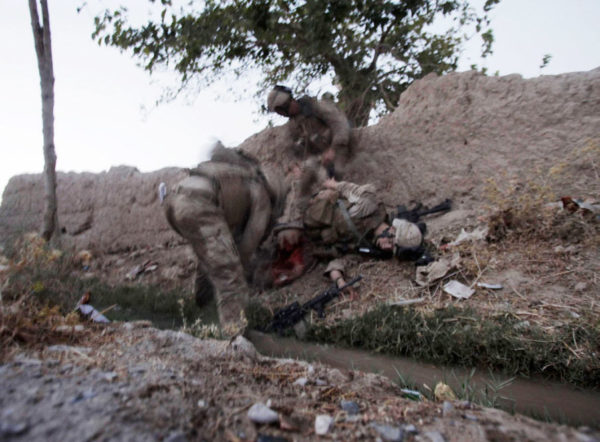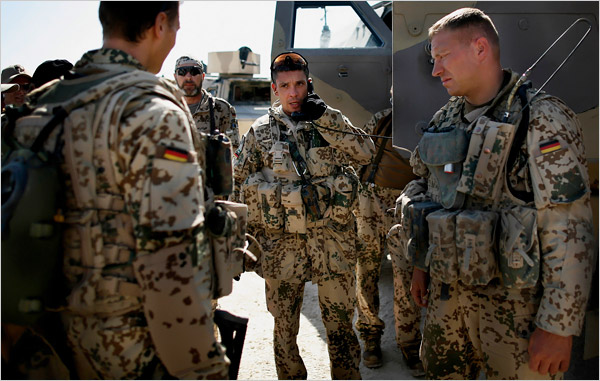Notes
Photo of a Dying Marine: The Larger View

Jacobson, in a journal she kept, recalled Bernard’s ordeal as she lay in the dirt while Marines tried to save their comrade with bullets overhead.
“The other guys kept telling him ‘Bernard, you’re doing fine, you’re doing fine. You’re gonna make it. Stay with me Bernard!'” As one Marine cradled Bernard’s head, fellow Marines rushed forward with a stretcher.
Later, when she learned he had died, Jacobson thought about the pictures she had taken.
“To ignore a moment like that simply … would have been wrong. I was recording his impending death, just as I had recorded his life moments before walking the point in the bazaar,” she said. “Death is a part of life and most certainly a part of war. Isn’t that why we’re here? To document for now and for history the events of this war?”
Later, she showed members of his squad all the images taken that day and the Marines flipped through them on her computer one by one.
“They did stop when they came to that moment,” she said. “But none of them complained or grew angry about it. They understood that it was what it was. They understand, despite that he was their friend, it was the reality of things.”
— from: AP via AOL referring to photographer Julie Jacobson’s documentation of Lance Cpl. Joshua M. Bernard being mortally wounded by a rocket-propelled grenade in Helmand province.
First, my condolences to the family of Lance Cpl. Joshua Bernard. Although I believe strongly in the release of this image, noting that a month had passed since his death (and the release of more heroic images), and that Joshua had since been buried and the family informed in advance that the photo would be published, I also recognize the family’s opposition and the additional pain it has caused.
That said, I have a few takes on the controversy surrounding the release of this photo….
1. Given that the military’s rules for visually documenting images of American casualties is so restrictive that it effectively constitutes ongoing censorship and corporate media is so skittish in the face of political push back, the fact this single photo of an American casualty even made the light of day is quite remarkable.
2. In the reaction in the discussion boards I’ve been looking at, there has been relatively little discussion of the dynamics of embedding. One effect of this procedure is that the newswires offer up a steady and anesthetizing stream of sympathetic and non-remarkable “can-do” images that mostly defy a larger context, narrative or independent definition of the war.
In that sense, it’s unfortunate an image like the one above is forced to do so much work — not just shocking the public into considering the war as real, but also reminding us that war photos can actually function singularly, beyond the realm of military PR, as truly independent journalism.
3. Given that Joshua was fated to die, is there no value to the fact a visual record exists providing his family a fuller picture of his end — including his service in the days before he died as well as the record of his comrades responding to his death and honoring him afterward?
If most reports focus on this single image and the question of whether it is gratuitous or not, I believe the visual issue here is harder to parse than that. Ms. Jacobson’s presence as an embed with the company for days before and after necessitates that we consider the totality of the visual record as well as potential positive emotional benefit derived from showing the story (as opposed to the event) of Joshua’s death.
Put another way, for all the parents who have little or no picture of how their child died, and then wonder in vain, the question to consider is the relative merit of this sensitive a rendition of the place, the day, the mission. I would consider this context in watching Ms. Jacobson’s audio slideshow of what happened that day.
4. Given the military rules that the photo must be taken from ” a respectful distance,” I have reservations whether this image should be described as graphic, even if its been labeled that way by many of the media outlets that stepped up to show it.
5. It’s worth noting that the photo above serves as a sobering and, dare I say, vital counterpoint to what, up to now, has been the most celebrated photo of the Afghan war, an image causing the Secretary of Defense to gush that courage is: “Any soldier who goes into battle against the Taliban in pink boxers and flip-flops….” (See BNN’s: Pink skivvies: Whitewashing The Afghan Campaign.)
Anesthetization, indeed.
For an extremely good summary of the controversy surrounding this AP photo, see the write-up at the NYT Lens blog: Behind the Scenes: To Publish or Not? If you have a chance, also take a look at the discussion thread.
(h/t: Ken. image: Julie Jacobson/AP, August 14, 2009)


Reactions
Comments Powered by Disqus